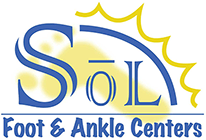Match the corresponding numbers on the diagram below for a list of conditions that may be causing your foot and ankle pain. Foot and ankle problems can develop for many different reasons: genetics, injury, lifestyle, diabetes, and even age. Often, it is a combination of these factors that cause foot pain.
|
Medial View of the Foot & Ankle
|
.jpg)
Number 1:
Plantar Fasciitis: is one of the most common causes of heel pain. Micro-tears along the plantar fascia cause pain and swelling in the arch and heel. Symptoms include pain when first stepping out of bed in the morning.
Calcaneal Fracture is a break in the heel bone that is often due to severe trauma such as a fall or auto accident. Severe pain, swelling, bruising, and inability to put weight on the affected foot.
Heel Spur: an abnormal bone growth on the calcaneus bone (heel bone) caused by the build-up of calcium deposits.
Number 2:
Tarsal Tunnel Syndrome: Symptoms include a sharp pain on the inside of the ankle that radiates down to the foot.
Calcaneal Apophysitis (Sever's Disease): Irritation, pain, and swelling to heel bone and growth plate. Children who develop Sever’s disease will usually complain of heel pain located at the very back and/or bottom of the heel. The pain usually increases with activity, especially running and jumping, and decreases with rest
Number 3:


Haglund Deformity / Pump Bump: A hard bony prominence on the back of your heel bone is commonly called a pump bump.
Achilles Tendonitis: Inflammation of the Achilles tendon due to overuse, injury, or abnormal mechanical functioning of the foot and ankle.
Retrocalcaneal Bursitis: Inflammation of the bursa located near the back of the heel bone and Achilles tendon.
Achilles Tendon Rupture: The Achilles tendon located at the back of the heel, can tear or become ruptured with sudden force and trauma to the foot or ankle.
Calcaneal Fracture: A Break in the heel bone is often due to severe trauma such as a fall or auto accident. Severe pain, swelling, bruising, and inability to put weight on the affected foot.
Number 4:![]()
Achilles Tendonitis: Inflammation of the Achilles tendon due to overuse, injury, or abnormal mechanical functioning of the foot and ankle.
Achilles Tendon Rupture: A complete tear of the Achilles tendon is located at the back of the heel. Achilles tendons can rupture with sudden force or trauma to the foot or ankle. It also can become weak over time increasing the possibility of rupture.
![]() Number 5:
Number 5:
Adult-Acquired Flatfoot Deformity: The progressive flattening of the arch of the foot.
Accessory Acicular: An extra bone in the foot is located on the inner side of the foot, just above the arch.
Tarsal Tunnel Syndrome: A condition where there is an abnormal connection of two or more bones in the back of the foot. Abnormality most frequently occurs during fetal development but may not be symptomatic until bone maturity.
Number 6:
Ankle Impingement![]() : Ankle pain and stiffness caused by spurs or pinching of soft tissues.
: Ankle pain and stiffness caused by spurs or pinching of soft tissues.
Ankle Arthritis: Pain, stiffness, and limited movement are caused by inflammation in the ankle joint. The most common types of arthritis that affect the foot are osteoarthritis and rheumatoid arthritis.
Ankle Sprain: An injury to one or more ligaments of the ankle. Symptoms may include pain, swelling, and discoloration associated with bruising. "Top Four Signs Your Ankle Injury Is Serious"
Ankle Fracture: A break or crack in one or more of the bones that makes up the ankle joint, also known as a broken ankle.
Number 7:
Midfoot Arthritis: Pain: Swelling, and inflammation in and around the midfoot that causes pain when standing and walking.
Lisfranc Injury/Fracture: A serious injury to the Lisfranc joint (where the metatarsal bones meet the tarsal bones) is caused by trauma such as an automobile accident or crush injury.![]()
Number 8:
Bunion: A bony, painful bump that forms at the base of the big toe causing pain and swelling. How do I treat my Bunion?
Hallux Rigidus: A disorder of the big toe joint that causes pain, stiffness, and swelling. A shoe that is too tight or too flexible can aggravate the big toe joint area causing more pain and swelling. Related Article on Hallux Rigidus
Turf Toe: Sprain of the great toe joint due to overuse or trauma.
Gout: The accumulation of uric acid in the joints and tissues of the body. Gout can be very painful and most commonly affects the big toe joint. Symptoms of gout include swelling, redness, and severe pain that makes walking difficult. " What You Need To Know About Gout"
This foot diagram is meant only for educational purposes. For diagnoses and treatment for your foot and ankle problem schedule an appointment with an experienced foot specialist by calling 562-433-0478.
(2).jpg)



(1).jpg)
.jpg)


